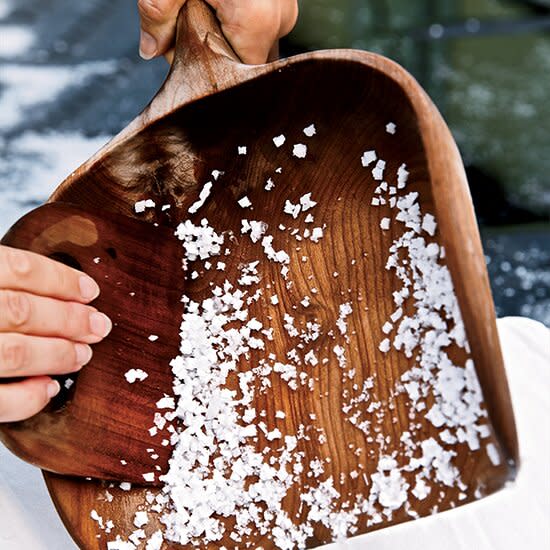Why Chefs Love This 600-Million-Year-Old Salt From West Virginia
- Oops!Something went wrong.Please try again later.

Olivia Rae James
Tapping brine reserves deep beneath West Virginia, a brother-sister team is harvesting remarkable salt. Here's why chefs adore it.
Hidden 300 feet beneath the Appalachian mountains are the remnants of the Iapetus Ocean, an ancient sea. The forgotten subterranean brine reserves lay untouched for 600 million years—that is, until 1813, when William Dickinson came to West Virginia's Kanawha Valley to prospect for salt. He drove hollowed-out sycamore trees into the ground, creating wells that tapped those pure, mineral-rich deposits to create the salt that would make his name.
Dickinson's descendants have been producing salt on the original 60-acre farm on and off for seven generations. In 2013, Nancy Bruns and Lewis Payne, his great-great-great-great-grandchildren, revived the saltworks after a 68-year lull, reintroducing J.Q. Dickinson Salt-Works to the world. Chefs have become its biggest boosters; Sean Brock of Husk in Charleston, South Carolina, says it makes him proud to be a Southerner. "So many things differentiate J.Q. Dickinson from other producers," says salt expert Mark Bitterman. "It's a historic saltworks. There are very few people today making salt from a well. That was a fundamental way of making it for millennia."
As Bitterman recounts in his book Salted: A Manifesto on the World's Most Essential Mineral, with Recipes, industrial manufacturing methods create salt without real character. By contrast, smaller-batch, unrefined salts like the ones from J.Q. Dickinson reflect the terroir of their source.
In the case of J.Q. Dickinson, that source, the Iapetus, is unique. Salt made from its brine was once the most highly regarded in the country, winning first prize at the London World's Fair in 1851. During the 1850s, J.Q. Dickinson was one of the largest salt producers in the US, joined by dozens of others in the Kanawha Valley. That salt became known as the Great Kanawha Salt and was shipped by boat to Cincinnati to supply the meatpacking industry.
But demand slowed during the Civil War, when the meatpacking industry began migrating from Cincinnati to Chicago. At the same time, the Morton Salt company tapped into large salt reserves in Michigan. The Kanawha salt industry suffered another serious blow during a flood in 1861. Still, the Dickinson family managed to recover and continued to produce salt until 1945.
Then, a few years ago, Nancy Bruns, a former chef, together with her husband, Carter, a historian, researched the valley's history and geology and learned that the ancient salt was still accessible, although the existing wells on the Dickinson property were not in working condition. "We needed to be making salt," she said. So when her brother found a map from the early 1900s, they followed it to the source. They dug a new well and revived production.
Their salt-making process is simple: Pumps draw the pristine brine from the well into a holding tank; from there, the brine flows to two so-called sun houses, each containing six beds. The whims of the sun and the wind take hold (replacing the furnaces used in the old days) to evaporate moisture. Workers with handmade wooden rakes groom and harvest the salt after it crystallizes.
J.Q. Dickinson salt is higher in minerals than mass-market salt, and this gives it a remarkably balanced flavor. In just over a year, it has gained some very high-profile fans. Brock uses it as a finishing touch on almost every dish that leaves his kitchen at Husk. Cathal Armstrong of Restaurant Eve in Alexandria, Virginia, says he loves the salt's story as much as its minerality. And it's the only salt Baltimore chef Spike Gjerde uses at Woodberry Kitchen. He developed the recipe on the next page to show it off. It's a simple dish of roasted beets, salted yogurt and a flurry of herbs—topped with a sprinkle of J.Q. Dickinson.
Brys Stephens is a food writer based in Charleston, South Carolina, and the author of The New Southern Table.
